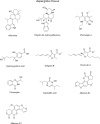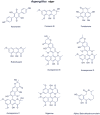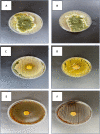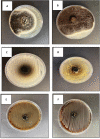Aspergillus Species from the Sabkha Marsh: Potential Antimicrobial and Anticancer Agents Revealed Through Molecular and Pharmacological Analysis
- PMID: 39130166
- PMCID: PMC11316488
- DOI: 10.2147/BTT.S472491
Aspergillus Species from the Sabkha Marsh: Potential Antimicrobial and Anticancer Agents Revealed Through Molecular and Pharmacological Analysis
Abstract
Introduction: This study aimed to investigate the fungal growth and diversity in the Sabkha marsh. The anti-bacterial properties of the isolated fungi were assessed using an agar disk diffusion assay, and the crude extracts were tested for their anticancer activities. Liquid chromatography-mass spectrometry was employed to identify the active compounds of the fungal secondary metabolites. In-silico studies were conducted to predict the toxicity, pharmacokinetic properties, and safety profiles of the identified compounds.
Results: The analysis revealed that the isolated fungi belonged to the Aspergillus species, specifically Aspergillus flavus and Aspergillus niger. The crude extract of A. flavus exhibited significant anticancer activity against various cancer cell lines, while the antifungal activities against pathogenic bacteria varied between the two fungi. Liquid chromatography-mass spectrometry analysis identified several compounds in the fungal isolates. In Aspergillus flavus, the compounds included Aflavinine, Dihydro-24-hydroxyaflavinine, Phomaligin A, Hydroxysydonic acid, Gregatin B, Pulvinulin A, Chrysogine, Aspergillic acid, Aflatoxin B1, and Aflatoxin G1. In Aspergillus niger, the compounds identified were atromentin, fonsecin B, firalenone, rubrofusarin, aurasperone E, aurasperone D, aurasperone C, nigerone, and αβ-dehydrocurvularin.
Conclusion: This study demonstrated promising fungal growth and diversity in the Sabkha marsh, with Aspergillus species being the most prevalent. The fungal crude extract showed anticancer activities against various cancer cell lines, while the antifungal activities against pathogenic bacteria varied between the two fungi. Future research should focus on investigating the antimicrobial activities of these fungi against multidrug-resistant bacteria and exploring the genetic changes in bacteria and cancer cells treated with these fungal extracts. Additionally, it is important to test the anticancer activity of the active compounds separately to determine which one is the active agent against cancer cells. This information can be used in drug development trials.
Keywords: Aspergillus genus; antimicrobial screening; biological activity; microbial isolation; saline environment.
© 2024 Sajer et al.
Conflict of interest statement
The authors report no conflicts of interest in this work.
Figures













Similar articles
-
Development of an analytical method for identification of Aspergillus flavus based on chemical markers using HPLC-MS.Food Chem. 2018 Feb 15;241:113-121. doi: 10.1016/j.foodchem.2017.08.065. Epub 2017 Aug 24. Food Chem. 2018. PMID: 28958507
-
Metabolic profiling, antimicrobial, anticancer, and in vitro and in silico immunomodulatory investigation of Aspergillus niger OR730979 isolated from the Western Desert, Egypt.Int Microbiol. 2024 Dec;27(6):1677-1691. doi: 10.1007/s10123-024-00503-z. Epub 2024 Mar 20. Int Microbiol. 2024. PMID: 38506948 Free PMC article.
-
HPLC, NMR Based Characterization, Antioxidant and Anticancer Activities of Chemical Constituents from Therapeutically Active Fungal Endophytes.J Microbiol Biotechnol. 2024 Jul 28;34(7):1452-1463. doi: 10.4014/jmb.2403.03036. Epub 2024 May 6. J Microbiol Biotechnol. 2024. PMID: 38858094 Free PMC article.
-
The effect of lichen secondary metabolites on Aspergillus fungi.Arch Microbiol. 2021 Dec 29;204(1):100. doi: 10.1007/s00203-021-02649-0. Arch Microbiol. 2021. PMID: 34964912 Free PMC article.
-
Marine-derived fungi from the genus Aspergillus (Ascomycota) and their anticancer properties.Mycology. 2024 Nov 4;16(2):545-592. doi: 10.1080/21501203.2024.2402309. eCollection 2025. Mycology. 2024. PMID: 40415918 Free PMC article. Review.
Cited by
-
Revealing culturable fungal microbiome communities from the Arabian Peninsula desert representing a unique source of biochemicals for drug discovery and biotechnology.F1000Res. 2024 Dec 17;13:1527. doi: 10.12688/f1000research.158130.1. eCollection 2024. F1000Res. 2024. PMID: 40104089 Free PMC article.
References
-
- Orfali R, Perveen S. New bioactive metabolites from the thermophilic fungus penicillium sp. isolated from ghamiqa hot spring in Saudi Arabia. J Chem. 2019;2019:1–7. doi:10.1155/2019/7162948 - DOI
LinkOut - more resources
Full Text Sources

